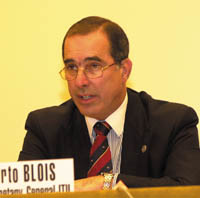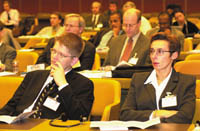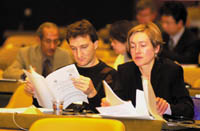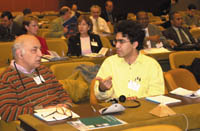Joint ITU/WIPO Symposium
Creating a wider understanding of the complex issues surrounding the
implementation of multilingual domain names
The last Plenipotentiary Conference of the International Telecommunication
Union (ITU), held in Minneapolis in 1998, decided that ITU should “take an
active part in the international discussion and initiatives on the management of
Internet domain names and addresses”.
 “While
expansion of the domain name space means greater opportunities for
legitimate users, it also opens up new opportunities for
cyber-squatters. We are keen on ensuring that the expansion does not
happen at the expense of any one party.” Francis Gurry, Assistant
Director General of WIPO “While
expansion of the domain name space means greater opportunities for
legitimate users, it also opens up new opportunities for
cyber-squatters. We are keen on ensuring that the expansion does not
happen at the expense of any one party.” Francis Gurry, Assistant
Director General of WIPO
|
On 6 and 7 December 2001, ITU and the World Intellectual Property
Organization (WIPO) jointly hosted a Symposium on Multilingual Domain Names at
Geneva’s International Conference Centre in association with the Multilingual
Internet Names Consortium (MINC) — a non-profit non-governmental organization
focusing on the promotion of multilingualisation of Internet names.
 “We
do not want to run the risk of fracturing access to the Internet and
as a result increase the digital divide between developed and
developing nations.” Roberto Blois, ITU Deputy Secretary-General “We
do not want to run the risk of fracturing access to the Internet and
as a result increase the digital divide between developed and
developing nations.” Roberto Blois, ITU Deputy Secretary-General
Photos: A. de Ferron (ITU 020018/ITU 020019) |
The Internet has become a global network of more than 230 connected economies
and over 360 million users. It is estimated that by 2003, two-thirds of all
Internet users will be non-English speakers, with the greatest expansion coming
from Asia and Latin America. It is further estimated that by that same year, at
least one-third of Web users will prefer to conduct their on-line activities in
a language other than English, and that by 2005 only one third of Internet
businesses will use English for on-line communication. Some forecasters even
predict that, by 2007, Chinese will be the primary language used on the World
Wide Web!
What is a domain name?
A domain name is used to identify an entity within the Internet
in a format that we human beings can easily understand.
Basically, it maps a human-readable name such as “www.itu.int”
to a machine-readable IP address (for example, 156.106.134.92).
In its current form, only a limited set of Latin or Roman ASCII
characters, namely: letters, digits and hyphens, can be used in
domain names. ASCII stands for American Standard Code for
Information Interchange, and is the most common format for text
files in computers and on the Internet. In an ASCII file, each
alphabetic, numeric, or special character is represented with a
7 bit binary number (a string of seven 0s or 1s).
|
This joint ITU/WIPO symposium was vital for an international dialogue to
address the evolution of the multilingual domain names. Some 200 participants
from the Internet and legal communities, as well as policy-makers and government
representatives reviewed the technical, legal and policy issues relating to the
enlargement of the domain name space to support scripts of languages other than
“Roman” characters.

Photos: A. de Ferron (ITU 020020/ITU 020021) |
A domain name, whether under a generic top-level domain like .com or a
country code top-level domain like .fr or .us, provides a global presence which
ensures that the corresponding on-line address is accessible online from
anywhere. More than 100 million such names are estimated to be already stored in
the Internet domain name system (DNS).
However, the language and scripts upon which the DNS is based have not
changed to reflect the Net’s global character. The DNS mapping technology has
always functioned using only a subset of Latin or “Roman” characters most
commonly used to write English.
“Native speakers of Arabic, Chinese, Japanese, Korean, Tamil, Thai and
other languages are at a disadvantage. The global nature of the Internet makes
international dialogue critical if a universal solution to the problem is to be
found,” said Roberto Blois, ITU Deputy Secretary-General, at the symposium’s
opening ceremony.
Several initiatives are under way to explore the means by which the DNS can
be internationalized to overcome the functional limitation of this naming and
addressing system. In particular, the Internet Engineering Task Force (IETF) has
been actively attempting to specify standards for internationalized access to
domain names.
As is often the case, market demand does not wait for technically perfect
solutions. Already, a number of commercial and private organizations have
proposed solutions that would enable multilingual domain name use, but de facto
or technical standards that would guarantee interoperability have yet to emerge.
Current implementations of multilingual domain names typically rely on
proprietary technology or incomplete technical specifications. Will new emerging
naming technologies not based on the DNS, such as keywords, become a preferred
solution? Or will hybrid technologies merging the DNS and keywords surface?

Photos: A. de Ferron (ITU 020022/ITU 020023) |
There are many more questions than answers. The result is a risk of confusion
in the marketplace among Internet users and providers. Mr Blois declared: “We
do not want to run the risk of fracturing access to the Internet and as a result
increase the digital divide between developed and developing nations.” Francis
Gurry, Assistant Director General of WIPO said: “The Internet has achieved its
remarkable success largely as a result of the fact that all users can access the
same Internet from any location in the world, and any development should give
priority to preserving this uniformity and stability.”
It was clear from the symposium discussions that the challenges are complex
and go far beyond technical considerations including, inter alia,
administrative arrangements for multilingual domains, competition policy, market
access, intellectual property and dispute resolution mechanisms, as well as
cultural and social issues. Many of these issues are discussed in the ITU and
WIPO Briefing Papers dealing with, respectively, “Technology and Policy
Aspects and “Internationalized Domain Names — Intellectual Property
Considerations” (see www.itu.int/mdns).
The domain name system
The Internet domain name system serves to facilitate the ability
of the user to navigate the Internet by mapping the domain name
to its corresponding numeric Internet Protocol (IP) address. DNS
operates on the basis of a hierarchy of names, with the top
layer taken by the generic top-level domains (gTLD) and country
code top-level domains (ccTLD). At the time of the symposium,
there were 243 ccTLDs, each bearing a two-letter country code
derived from ISO 3166 – a standard from the International
Organization for Standardization.
Until recently, there were seven gTLDs, comprising the “open”
or unrestricted gTLDs of .com, .net, .org and the restricted
gTLDs of .int, .edu, .gov and .mil. In November 2000, the
Internet Corporation for Assigned Names and Numbers Board
selected seven new top-level domains to be introduced into the
DNS, comprising the “unsponsored” gTLDs of .biz (for
business purposes), .info (unrestricted) and .name (for personal
names), as well as the “sponsored” gTLDs of .aero (for the
aviation community), .coop (for cooperatives), .museum (for
museums) and .pro (for professionals).
|
“Equality of access to the valuable resources provided by the Internet is
an issue of critical importance to the international community, and is a key
concern for international intergovernmental organizations, such as ITU and WIPO.
Also, while expansion of the domain name space means greater opportunities for
legitimate users, it also opens up new opportunities for cybersquatters. We are
keen on ensuring that the expansion does not happen at the expense of any one
party,” Mr Gurry observed.
A bit of history…
An early effort to develop multilingual domain names started in Asia in the
late 1990s, where consumer demand is said to be growing strong. Multilingual
domain names were first developed at the National University of Singapore. In
July 1998, a working group on Internationalization of the DNS was formed within
the Asia Pacific Networking Group (APNG) in a bid to coordinate the evolution of
multilingual domain names. One of the group’s projects was to develop the
experimental implementation of an Internationalized Multilingual Multiscript
Domain Names Service (iDNS).
Governmental, academic and industry entities from China, Hong Kong, Japan,
the Republic of Korea, Singapore, Taiwan, and Thailand participated in the iDNS
project. Another project, called iDomain, had the objective of creating an iDNS
test bed in Asia-Pacific countries.
In August 1998, a multilingual domain name system was demonstrated to
delegates at an International Forum on the White Paper meeting in Singapore. By
the end of that year, several countries and economies including China, Hong
Kong, Japan, the Republic of Korea, Singapore and Thailand had expressed an
interest in implementing such a system.
At the end of 1999, several companies (including a commercial spin-off of the
Asia Pacific iDNS initiative called iDNS.net International Inc.) began to
commercialize the technology that had been developed. By 2000, several test beds
had been deployed around the world to offer multilingual domain names.
By 2001 a number of organizations had been established to fill what was
believed to be a policy vacuum, and are now actively pursuing the deployment of
multilingual domain names. These are: MINC, the Arabic Internet Names Consortium
(AINC), the Chinese Domain Name Consortium (CDNC), the International Forum for
IT in Tamil (INFITT) and the Japanese Domain Names Association (JDNA).
The Internet Corporation for Assigned Names and Numbers (ICANN) formally
started its activities on multilingual domain names following a meeting in March
2001, where it established an internal Internationalized Domain Names (IDN)
Working Group comprising four of its Board Members. After a “fact finding
mission”, this working group reported its findings to a September 2001 meeting
of the ICANN Board. Its report indicated that there was great demand for
multilingual domain names. Based on these findings, the ICANN Board adopted a
resolution which recognizes that “it is important that the Internet evolve to
be more accessible to those who do not use the ASCII-character set” and
stresses that “the internationalization of the Internet domain name system
must be accomplished through standards that are open, non-proprietary, and fully
compatible with the Internet’s existing end-to-end model and that preserve the
globally unique naming in a universally resolvable public space”.
Intellectual property issues in a multilingual world
Looking at the challenges which intellectual property holders and
administrators face on a daily basis in protecting trademarks, symposium experts
in intellectual property and Internet technology shared experiences that may
lead to a greater understanding of the issues raised by an increasingly
internationalized domain name space. Key among those issues is the critical
challenge faced by enterprises in protecting their intellectual property in a
multilingual world, both on and offline, and the need for effective dispute
resolution to resolve the domain name conflicts that will inevitably arise.
The Internet Corporation
for Assigned Names and Numbers Board adopted a resolution which
stresses that “the internationalization of the Internet domain
name system must be accomplished through standards that are open,
non-proprietary, and fully compatible with the Internet’s existing
end-to-end model and that preserve the globally unique naming in a
universally resolvable public space”
|
WIPO’s Briefing Paper explains that intellectual property and identifiers,
such as trademarks and trade names, play an important role in commerce in both
physical and virtual worlds. “In both these environments, such intellectual
property identifiers, as well as new identifiers such as domain names, are
valuable in distinguishing products and services from others offered by
competing enterprises. The growing trend towards globalization and the increase
in world trade have accelerated the internationalization of the intellectual
property system and heightened the importance of such identifiers.” This trend
is furthered by the advent of e-commerce in an on-line environment, for the role
that such identifiers play in developing consumer awareness and trust towards
brands that are newly emerging and lack the conventional bricks and mortar
foundations.
Another WIPO report states that the “problem of conflicting trademarks
across different languages and different language scripts is a problem that is
already well known to the trademark community, which has a long experience with
trademark registrations being effected in the various languages and language
scripts used around the world. It is expected, however, that the introduction of
internationalized domain names will introduce added dimensions to the problem of
conflicting identifiers across different languages and language scripts.”
These new dimensions may include evaluating the importance of phonetic
similarity in the context of a largely visual or textual medium, the speed and
relatively low cost with which a domain name registration can be obtained;
compared to the time and cost associated with obtaining trademark registrations.
The joint ITU/WIPO symposium was a first step in bringing about a wider
understanding of the many complex issues surrounding the implementation of
multilingual Internet names. Mr Gurry says: “We welcome an orderly expansion
of the domain name system which more accurately reflects the linguistic
diversity of the offline world and is done in a way that preserves the rights of
intellectual property owners.”
|